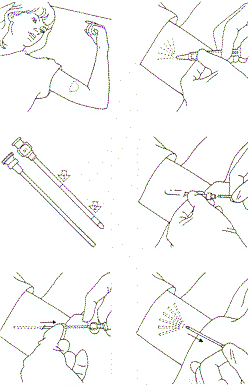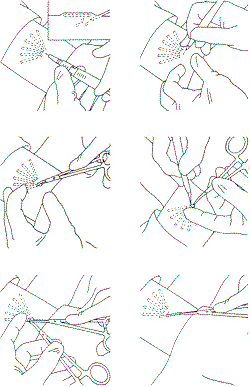Norplant
Norplant consists of six soft, flexible Silastic tubes, each containing
levonorgestrel (LNG, the same progestational agent found in LoOvral), and implanted just below the skin of the
inner, upper arm. The tubes are 34 mm long and 2.4 mm in diameter, and initially release
about 85 mcg of LNG each day. In time, the daily release of LNG falls, ultimately
stabilizing at about 30 mcg per day. If left in place, the tubes continue to effectively
prevent pregnancy for at least 5 years.
It is believed to exert its' contraceptive effect by some or all of the
following:
- Inhibiting ovulation
- Changing cervical mucous
- Changing the lining of the uterus
- Altering fallopian tube function
- Other, as yet unclassified mechanisms
When removed, fertility returns promptly.
Effectiveness
During the first year of use, the failure rate is 0.2%, comparable to
the failure rate of BCPs. During the next 5 years, the failure rate rises slowly to
about 1% by the 5th year.
Contraindications
- Undiagnosed vaginal bleeding
- Known or suspected pregnancy
- Known or suspected breast cancer
- Active thrombophlebitis or thromboembolism
- History of idiopathic intracranial hypertension
- Benign or malignant liver tumors or other acute liver disease
- Known hypersensitivity to LNG or Silastic
Abnormal Bleeding
About half of all women using Norplant will experience abnormal bleeding
patterns, consisting of spotting, prolonged bleeding, unpredictable onset of flow and
amenorrhea, primarily in the first year of use. While overall, the number of days of some
bleeding in these women usually increases, the total amount of blood loss usually
decreases, and anemia is not a problem. This side effect, abnormal bleeding, is generally
tolerated and no treatment is necessary. For the woman who is quite distressed, or in whom
the bleeding is clinically significant, control with BCPs is usually effective, but may
alter the effectiveness of the method and theoretically could lead to an increased risk of
thrombophlebitis or other hormone-related side effect. Removal of the implants may
occasionally be necessary.
Weight Gain or Loss/Nausea/Depression
These have all been reported in association with this drug, but it is
unknown whether they occur more frequently among women using the implants or not using the
implants. If the symptoms are mild, toleration will usually bring relief in time. If
symptoms are severe, removal of the implants may be necessary.
Infection
Infection at the implant site is an uncommon complication (0.7%), but is
treated by removal of the implants, bacterial cultures and antibiotics.
Insertion
The implants are inserted in the inner, upper arm (non-dominant side),
8-10 cm above the elbow crease, in a fan-like pattern, just beneath the dermis.
When in place, they are typically invisible, but may be seen in
extremely thin patients.
In women with darker skin tones, a hyperpigmentation (even darker area)
may develop over the implants, outlining their position, but this coloration is temporary
and resolves after removal of the implants. They can be felt, but will not move or migrate
away from the insertion site.
After giving a small amount of local anesthetic, 2 mm incision in the
skin is made and a trocar introduced. Through the trocar, the Silastic tubes are inserted
in a fan-like fashion (see illustration). The incision to closed with a steri-strip.

Illustration Courtesy of Wyeth-Ayerst Laboratories,
Philadelphia, Pennsylvania
Removal
Local anesthetic is injected to allow a 3-5 mm skin incision at the base
of the "fan." (see illustration) 3 ml of anesthetic in injected beneath
the implants. Push one implant toward the incision with your fingers and grasp it with a
hemostat. Before it can be removed, you will need to open the fibrous capsule which will
have developed around the implant. Open the capsule with a scalpel or another hemostat.
Then grasp the implant and pull it straight out through the incision. Continue in the same
way with the other implants until all 6 are removed.
Sometimes, there will have been some migration of the implants, making
removal of all of them difficult. Under these circumstances, if reasonable efforts to
retrieve all of them are not successful, it may be better to stop, wait 4-6 weeks for
healing and resolution of any inflammation, and then try again.
New implants may be inserted at the time of the removal of the old ones,
either in the same or in the opposite direction

Illustration Courtesy of Wyeth-Ayerst Laboratories,
Philadelphia, Pennsylvania
*Norplant is the registered trademark of the Wyeth-Ayerst
Laboratories, Philadelphia, Pennsylvania
Bureau of Medicine and
Surgery
Department of the Navy
2300 E Street NW
Washington, D.C.
20372-5300 |
Operational Obstetrics
& Gynecology - 2nd Edition
The Health Care of Women in Military Settings
CAPT Michael John Hughey, MC, USNR
NAVMEDPUB 6300-2C
January 1, 2000 |




